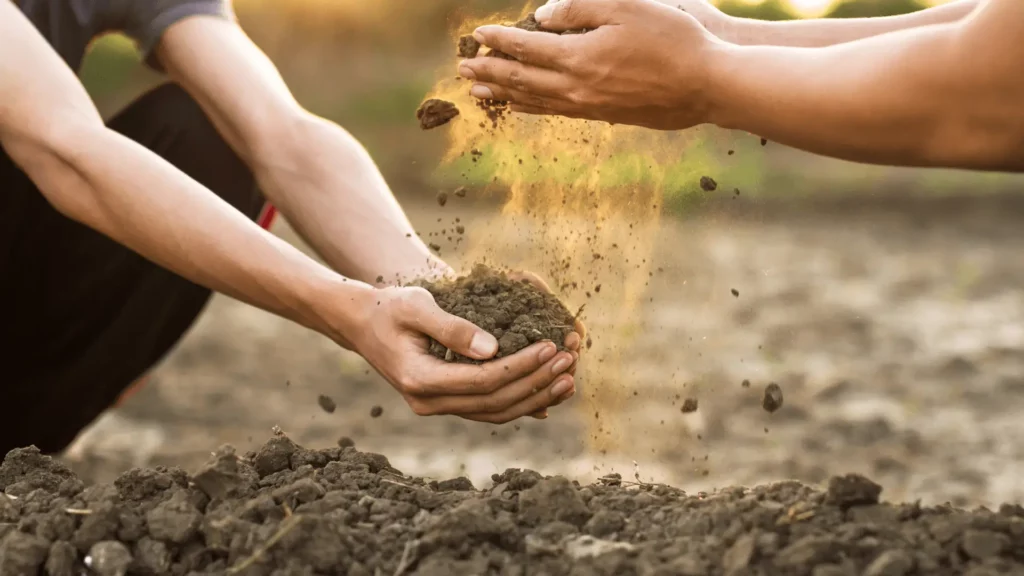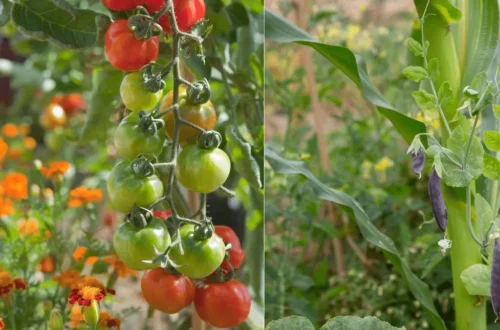The Ultimate Guide to Making Organic Soil for a Healthy Vegetable Garden

Are you ready to take your vegetable garden to the next level? Imagine lush, vibrant plants, bountiful harvests, and the satisfaction of knowing you’re growing your veggies the natural way. It all starts with the foundation: organic soil.
But what exactly makes organic soil so special? Why should you invest your time and effort into creating your own? In this ultimate guide, we’ll answer all your questions and provide step-by-step instructions to help you make the best organic soil for your vegetable garden.
We’ll discuss the importance of using natural ingredients such as peat moss and compost, which help improve soil structure and water retention. By understanding the balance of nutrients and utilizing lightweight materials like coconut coir, you can create a high-quality soil mix without spending a fortune. We’ll also explore the benefits of nutrient retention, plant fertility, and sustainable gardening practices, so you can enjoy healthy and delicious homegrown vegetables all season long.
Introduction to Making Organic Soil for Vegetable Gardens
Organic soil is a crucial component when it comes to successful vegetable gardening. By using natural ingredients and following simple DIY techniques, you can create nutrient-rich soil that promotes plant growth, improves soil structure, and enhances the health of your vegetable garden.
But why is organic soil so important? Well, organic soil provides numerous benefits not only to the plants but also to the environment. Here are a few key reasons why you should consider making your own organic soil for your vegetable garden:
1. Nutrient-rich: Organic soil is packed with essential nutrients that are slowly released to nourish plants over time. It provides a well-balanced diet for your vegetables, ensuring they receive the proper nutrition to grow vigorously.
2. Improved soil structure: Organic soil helps in improving soil structure by enhancing its ability to retain water and nutrients. This creates an optimal environment for plant roots to grow deep and establish a strong foundation.
3. Enhanced microbial activity: Organic soil is teeming with beneficial microorganisms that help break down organic matter, release nutrients, and promote overall soil health. These microorganisms play a vital role in nutrient cycling and soil fertility.
4. Reduced environmental impact: By using organic soil, you minimize the use of synthetic fertilizers and pesticides, which can harm beneficial insects, pollinators, and even the surrounding ecosystem. Organic gardening practices contribute to a healthier and more sustainable environment.
So, if you want to achieve abundant and healthy harvests from your vegetable garden while also reducing your environmental footprint, making organic soil is the way to go. In the upcoming sections, we will dive deeper into the components of organic soil mix and guide you through the process of creating your high-quality organic soil. Remember, a thriving vegetable garden starts with the foundation of healthy, nutrient-rich soil.
Understanding the Components of Organic Soil Mix
When it comes to creating organic soil for your vegetable garden, understanding the key components is essential. These components work together to provide the ideal environment for your plants to thrive.
One important ingredient in organic soil mix is peat moss. It acts as a moisture retainer, helping to prevent water loss and maintain the right level of hydration for your plants. Another component is organic matter, which improves soil structure and provides essential nutrients. Lastly, coconut coir is a sustainable alternative to peat moss, offering excellent water retention abilities.
By incorporating these components into your organic soil mix, you can ensure nutrient-rich, well-draining soil that promotes healthy and robust vegetable growth.
Selecting a Variety of Compost Sources
Using a variety of compost sources in your organic soil mix is crucial for enhancing fertility and providing a wide range of nutrients to your vegetable garden. By incorporating different types of compost, you ensure that your plants receive a balanced and diverse nutrient profile.
Here are some key reasons why selecting a variety of compost sources is important:
1. Enhanced Fertility: Each compost source brings its unique set of nutrients, microorganisms, and organic matter. By combining different compost materials, you enrich the soil with a broader range of nutrients, promoting healthier plant growth.
2. Nutrient Diversity: Different compost sources contribute varying levels of essential nutrients, such as nitrogen, phosphorus, and potassium. By utilizing a mix of compost, you ensure that your plants receive a balanced supply of these vital elements.
3. Microbial Activity: Each compost source carries its own community of beneficial microorganisms. Incorporating a variety of compost materials fosters diverse microbial populations in the soil, which contribute to nutrient cycling and overall soil health.
4. Sustainable Practices: By using a variety of compost sources, you reduce your dependence on a single material, making your gardening practices more sustainable. It also allows you to make use of available organic waste materials, reducing landfill waste.
When selecting compost sources, consider using a combination of well-rotted manure, vegetable scraps, leaf litter, grass clippings, and kitchen compost. Each of these materials brings specific benefits to your soil and helps create a nutrient-rich environment for healthy and productive vegetable gardening.
Remember, the key is to maintain a balance in the selection of compost sources, ensuring a diverse and nutritious soil mix for your plants to thrive.
Also read: The Ultimate Guide to Soil Preparation for Your Garden
Balancing Water Retention and Drainage
A crucial aspect of creating organic soil for your vegetable garden is achieving the right balance between water retention and drainage. This balance ensures that your plants receive adequate moisture while preventing waterlogged conditions that can lead to root rot or other issues.
To achieve this balance, consider the following tips:
1. Proper soil texture: Use a mix of particle sizes to promote good drainage. Incorporate materials like sand or perlite to increase soil porosity and prevent water from pooling.
2. Organic matter: Adding compost or well-rotted manure helps improve soil structure, enhancing drainage capacity. These organic materials also increase water-holding capacity, preventing excessive water loss.
3. Raised garden beds: Elevating your garden beds can improve drainage, especially if your soil has a high clay content. This allows excess water to drain away more easily.
4. Mulching: Apply a layer of organic mulch around your plants to help regulate soil moisture levels. Mulch acts as a barrier, reducing water evaporation from the soil surface and preventing runoff during heavy rains.
Remember, the key is to find a balance that works for your specific garden and its watering needs. Regular monitoring of soil moisture levels and adjusting watering practices accordingly will help you maintain an optimal balance between water retention and drainage.
By ensuring proper water management, you can promote healthy root development, prevent water-related diseases, and create an ideal growing environment for your vegetable plants.
Also read: Essential Steps for Preparing Soil for Blueberry Plants
Enhancing Soil Structure with Lightweight Materials
Improving soil structure and aeration is essential for the optimal growth of vegetables in your garden. One effective way to achieve this is by incorporating lightweight materials into your organic soil mix. Vermiculite is a great option to consider.
– Vermiculite is a naturally occurring mineral that expands when heated, creating a lightweight and porous material.
– Adding vermiculite to your soil mix helps improve its structure, allowing for better water drainage and root penetration.
– The increased porosity of the soil allows for improved oxygen flow to the roots, promoting healthier plant development.
– Vermiculite also acts as an excellent water-retaining material, ensuring that your plants receive adequate hydration.
By including vermiculite in your organic soil mix, you are enhancing its overall quality and creating an environment that is conducive to the growth and success of your vegetable garden.
Incorporating Nutrient-Rich Additives
To enhance the nutritional content of your organic soil, consider incorporating nutrient-rich additives like plant fertilizer. By adding these additives, you can ensure that your vegetables receive the essential nutrients they need for healthy growth and abundant yields. Choose high-quality, organic fertilizers that provide a balanced mix of nutrients to promote optimal plant nutrition and overall soil fertility.
Also read: The Ultimate Guide to Preparing Soil for Sod Installation
Ensuring Nutrient Retention and Availability
To optimize nutrient retention and availability in your organic soil mix, there are a few key strategies you can implement. These techniques will help ensure your vegetable plants receive the necessary nutrients for healthy growth and abundant harvests.
1. Compost Tea: Create a nutrient-rich compost tea by steeping compost in water. This liquid fertilizer can be applied to your organic soil to provide readily available nutrients to your plants.
2. Mulching: Cover the soil surface around your vegetable plants with organic mulch, such as straw or shredded leaves. Mulching helps retain soil moisture and prevents nutrient leaching, ensuring the nutrients remain accessible to the plants.
3. Crop Rotation: Rotate your vegetable crops each year to avoid depleting specific nutrients from the soil. This practice helps maintain a balanced nutrient profile in the soil, reducing the risk of nutrient deficiencies.
4. Cover Cropping: Plant cover crops, such as legumes or grasses, during the off-season to enhance nutrient retention. These cover crops capture nitrogen from the air and transfer it back into the soil through their roots.
5. Companion Planting: Utilize companion planting techniques to maximize nutrient uptake. Certain plant combinations can enhance nutrient availability by providing natural fertilization and improving nutrient absorption.
By implementing these strategies, you can maximize nutrient retention and availability in your organic soil mix, promoting healthier and more productive vegetable plants.
Also read: The Ultimate Guide to Preparing Soil for Grass Seed
Step-by-Step Guide to Making Organic Soil for Vegetable Gardens
Creating your own organic soil mix is an excellent way to enhance the fertility and productivity of your vegetable garden. By using natural ingredients and following a simple step-by-step process, you can ensure that your plants receive the nutrients they need for healthy growth and abundant harvests. Here is a detailed guide on how to make organic soil for vegetable gardens.
Step 1: Gather the Ingredients
Before you begin mixing the soil, gather all the necessary components. You will need peat moss, organic matter, coconut coir, compost, lightweight materials like vermiculite, and plant fertilizer.
Step 2: Determine the Ratios
To create a well-balanced soil mix, it is important to follow the recommended ratios. A general guideline is to use equal parts peat moss, organic matter, and coconut coir. However, you can adjust the ratios based on the specific needs of your plants and soil conditions.
Step 3: Prepare the Organic Matter
In a separate container, mix the compost and organic matter together. This combination will provide essential nutrients and enrich the soil with organic material. Be sure to use a variety of compost sources to ensure a diverse range of nutrients.
Step 4: Add Peat Moss and Coconut Coir
In a large container or wheelbarrow, combine the peat moss and coconut coir. These materials help improve water retention and drainage in the soil. Mix them thoroughly to ensure an even distribution.
Step 5: Incorporate Lightweight Materials
To enhance soil structure and aeration, add lightweight materials like vermiculite to the mixture. Vermiculite is a great water-retaining material that also improves drainage. Incorporate it evenly into the mixture.
Step 6: Integrate the Organic Matter
Gradually add the prepared organic matter to the mixture of peat moss, coconut coir, and lightweight materials. Use a shovel or garden fork to thoroughly mix the components together. This step ensures that all nutrients are evenly distributed throughout the soil.
Step 7: Enhance Nutritional Content
To further enrich the soil, add plant fertilizer or other nutrient-rich additives. These additives will help provide the necessary nutrients for optimal plant growth and development. Follow the instructions on the fertilizer packaging for the correct application rates.
Step 8: Mix Thoroughly
Once all the components are added, mix the soil thoroughly to ensure an even blend of materials. Use a garden fork or a soil mixer to achieve a homogeneous mixture.
Step 9: Test and Adjust
Before using the organic soil mix in your vegetable garden, it is a good practice to test its nutrient content and pH levels. Adjust the pH if necessary by adding organic amendments like lime or sulfur.
Step 10: Apply to Your Vegetable Garden
Finally, apply the homemade organic soil mix to your vegetable garden. Ensure that you have sufficient depth for plant roots to grow and thrive. Gently work the soil into the existing garden bed or fill containers with the soil mix.
By following this step-by-step guide, you can create a high-quality organic soil mix for your vegetable garden. This DIY approach allows you to save money while promoting healthy plant growth. With nutrient-rich soil, your vegetable garden will thrive, providing you with a bountiful and delicious harvest. Enjoy the benefits of organic gardening and the satisfaction that comes with nurturing your plants from the ground up.
Also read: The Ultimate Guide to Fertilizing Soil for Healthy Plant Growth
Conclusion
Using organic soil in vegetable gardening is essential for creating a healthy and sustainable garden. By taking a DIY approach and making your organic soil mix, you can ensure the quality and productivity of your vegetable garden.
Organic soil provides numerous benefits to both plants and the environment. It promotes the growth of strong and vigorous plants, resulting in abundant and nutritious harvests. Additionally, organic soil helps retain moisture, enhances soil structure, and improves nutrient availability, all of which are crucial for the optimal growth of vegetables.
By utilizing natural ingredients such as peat moss, organic matter, and coconut coir, you can create a high-quality soil mix that is rich in nutrients. Incorporating a variety of compost sources further enriches the soil, providing a balanced range of nutrients.
Taking the DIY approach to make organic soil not only saves you money but also allows you to have control over the quality of the soil. By utilizing lightweight materials like vermiculite, you can ensure proper soil structure and enhance drainage.
In summary, when you make your own organic soil for vegetable gardening, you are creating a nurturing environment that promotes the health and vitality of your plants. So, roll up your sleeves, follow the step-by-step guide provided, and embark on the journey of creating a thriving and sustainable vegetable garden. Enjoy the experience of growing your own organic produce and reaping the rewards of a bountiful harvest!





